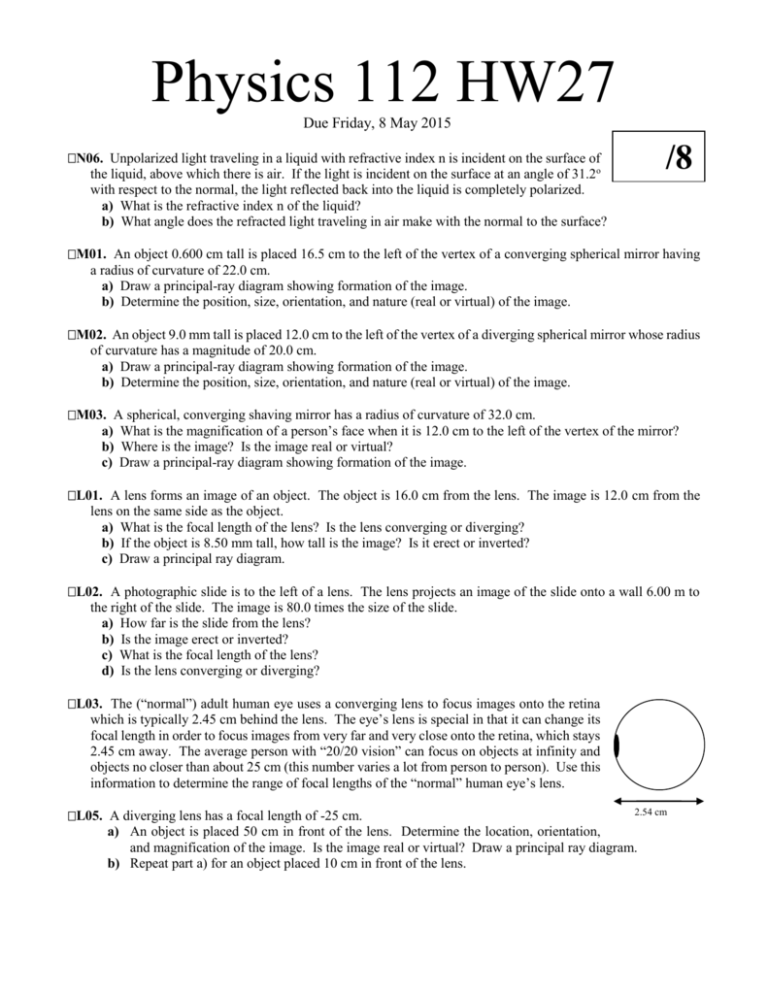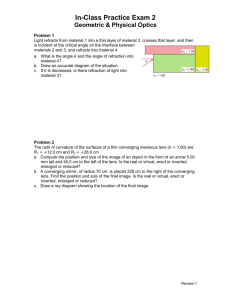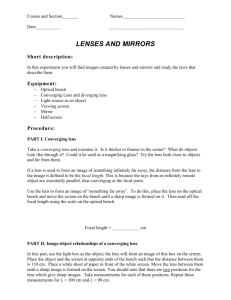Physics 212 HW17 - University of St. Thomas
advertisement

Physics 112 HW27 Due Friday, 8 May 2015 N06. Unpolarized light traveling in a liquid with refractive index n is incident on the surface of the liquid, above which there is air. If the light is incident on the surface at an angle of 31.2o with respect to the normal, the light reflected back into the liquid is completely polarized. a) What is the refractive index n of the liquid? b) What angle does the refracted light traveling in air make with the normal to the surface? /8 M01. An object 0.600 cm tall is placed 16.5 cm to the left of the vertex of a converging spherical mirror having a radius of curvature of 22.0 cm. a) Draw a principal-ray diagram showing formation of the image. b) Determine the position, size, orientation, and nature (real or virtual) of the image. M02. An object 9.0 mm tall is placed 12.0 cm to the left of the vertex of a diverging spherical mirror whose radius of curvature has a magnitude of 20.0 cm. a) Draw a principal-ray diagram showing formation of the image. b) Determine the position, size, orientation, and nature (real or virtual) of the image. M03. A spherical, converging shaving mirror has a radius of curvature of 32.0 cm. a) What is the magnification of a person’s face when it is 12.0 cm to the left of the vertex of the mirror? b) Where is the image? Is the image real or virtual? c) Draw a principal-ray diagram showing formation of the image. L01. A lens forms an image of an object. The object is 16.0 cm from the lens. The image is 12.0 cm from the lens on the same side as the object. a) What is the focal length of the lens? Is the lens converging or diverging? b) If the object is 8.50 mm tall, how tall is the image? Is it erect or inverted? c) Draw a principal ray diagram. L02. A photographic slide is to the left of a lens. The lens projects an image of the slide onto a wall 6.00 m to the right of the slide. The image is 80.0 times the size of the slide. a) How far is the slide from the lens? b) Is the image erect or inverted? c) What is the focal length of the lens? d) Is the lens converging or diverging? L03. The (“normal”) adult human eye uses a converging lens to focus images onto the retina which is typically 2.45 cm behind the lens. The eye’s lens is special in that it can change its focal length in order to focus images from very far and very close onto the retina, which stays 2.45 cm away. The average person with “20/20 vision” can focus on objects at infinity and objects no closer than about 25 cm (this number varies a lot from person to person). Use this information to determine the range of focal lengths of the “normal” human eye’s lens. 2.54 cm L05. A diverging lens has a focal length of -25 cm. a) An object is placed 50 cm in front of the lens. Determine the location, orientation, and magnification of the image. Is the image real or virtual? Draw a principal ray diagram. b) Repeat part a) for an object placed 10 cm in front of the lens.








